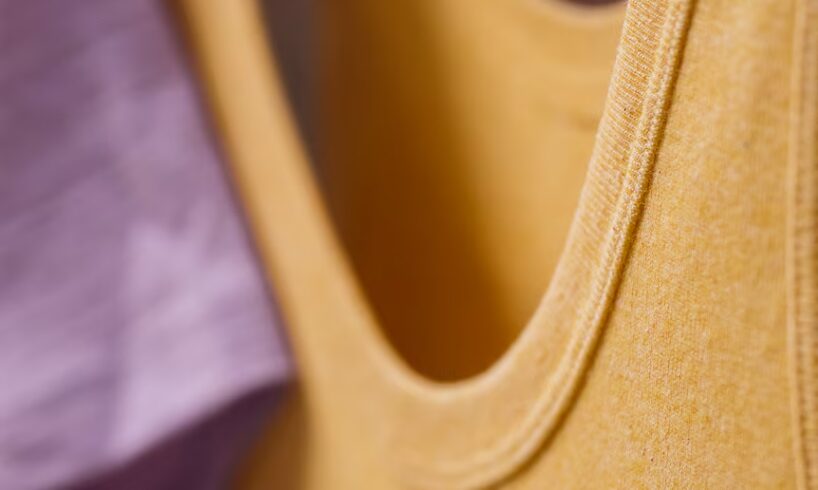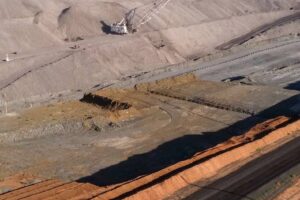
An all-Australian team behind a new fabric blending premium cotton and low-value wool hopes it will revitalise domestic clothing manufacture.
A collaboration between scientists, farmers and the fashion industry, the Mud to Marle project set out to shake up textile production in Australia.
The fabric is a blend of wool and cotton. (Supplied: Stu Ross/Milk Video)
“All the things that could be done with textiles, if only we were given the chance rather than constantly asked to do the cheapest, fastest thing,” project lead Meriel Chamberlin said.
Looking to tackle some of the biggest issues in the clothing supply chain, the Queensland-based textile scientist wanted to create a sustainable fabric that could be made from start to finish in Australia.
“The idea was: What would it look like if we could combine the natural properties of wool and cotton to create some fabrics that could be super low [environmental] impact?” she said.
“It was looking to take out as many processes as possible and still create something lovely.”
The wool fibre is dyed before spinning. (Supplied: Stu Ross/Milk Video)
The result is both a knitted and woven fabric they hope will challenge how Australians think about clothing.
The experiment
The UN estimates global textile production doubled between 2000 and 2015.
More than half of that is synthetic and each year the industry produces 92 million tonnes of waste.
Using a grant from the Country Road Climate Fund, Ms Chamberlin called on the expertise of Chris Hurren, from Deakin University’s Institute for Frontier Materials, and weaving mill and dye house Loomtex.
Meriel Chamberlin (left), Chris Hurren and Samantha Van Zyl. (Supplied: Deakin University )
Dr Hurren said they wanted to use the natural cotton and wool already produced in Australia, but there was a shortcoming.
“Traditionally they’re not blended together because cotton [fibre] has a length around the 30 millimetre mark, and wool is generally around the 70mm mark,” he said.
Wool and cotton aren’t usually blended into fabric because the fibres are different lengths and they’re hard to dye together. (Supplied: Eqwools)
To make a fabric, fibres of similar length are spun together to create yarn or thread, which is then knitted or woven.
But if the fibres are different lengths, the process is more complex, often making the end product more expensive.
To overcome that challenge, the team used fleece too short for a traditional wool spinning mill.
“Wool that would normally come off the bellies, the crutches and the legs — the little bits around the edge of a fleece,” Dr Hurren said.
The shorter wool can be spun in a cotton spinning system, but he said it was almost impossible to dye them together because plant-based and animal-based fabrics require different techniques.
Different lengths of wool and cotton fibres. (Supplied: Eqwools)
Dr Hurren said the team decided to dye the wool only before blending the two fibres, which created a colour effect known as a marle — hence, Mud to Marle.
“About 60 per cent of the energy that goes into making a textile goes into colouring,” Dr Hurren said.
“We only dyed 30 per cent of the fibre, which meant that we only used 30 per cent of the energy that went into the dyeing process and 30 per cent of the chemicals and water and so forth.
“That had a big offset on the environmental impact of the textile.”
The yarn is spun at Deakin University, then woven and knitted into fabric at Loomtex. (Supplied: Stu Ross/Milk Video)
The wool was taken to Loomtex in Geelong, Victoria, to be dyed.
Loomtex chief executive Samantha Van Zyl said they chose dyes certified as sustainable and mapped the carbon emissions.
“I found that the different colours that we used for the project — lighter versus darker, yellow versus blue — had quite significant emission changes,” Ms Van Zyl said.
The shorter wool fibres are spun in seven different countries. (Supplied: Eqwools )
It was then sent back to Deakin University to be spun before returning to Loomtex to be knitted and woven for hoodies, dresses, T-shirts and even a denim.
“The knit’s got quite a bit of stretch to it, but it will keep you warm and also offer breathability to keep you cool as well,” Ms Van Zyl said.
“[The denim] was quite soft. It’s really luxurious, actually. It’s quite a nice fabric.”
The next challenge
The cotton was sourced from Queensland and the wool was supplied by Michell Wool in South Australia.
Eqwools was created by South Australian company Michell Wool. (Supplied: Eqwools)
The company had already worked with Deakin University on their own fibre innovation project — Eqwools — which also uses short wool in the cotton spinning system.
General manager Gaynor Scott said they had been producing commercially for a year.
“We are now spinning our wool fibre … in seven countries and 24 cotton spinners across the world,” she said.
Wool and cotton spinning is the only step of textile manufacturing not available in Australia (Supplied: Eqwools)
Currently, all cotton and wool spinning is done offshore in countries including China, Vietnam and Bangladesh.
But Ms Chamberlain said the Mud to Marle team hoped to fully manufacture garments in Australia.
“We’re only missing one stage to be able to make things fully onshore in textiles — that’s spinning,” Ms Chamberlain said.
She said other parts of the supply chain — like wool scouring, cotton ginning and textile and garment manufacturing — were still done in Australia, though at a smaller scale.
“Lots of people think there’s nothing here, but actually there still is but it’s use it or lose it. It’s like a muscle,” Ms Chamberlain said.
The Australian Fashion Council said that after decades of decline, the textile manufacturing sector was at a critical tipping point, although there were signs of stabilisation.
It is due to deliver a national manufacturing strategy to bring the textile industry home later this year.





